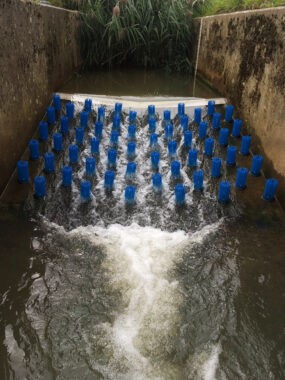Understanding fish-hydrodynamic interactions within Cylindrical Bristle Cluster arrays to improve passage over sloped weirs
Daniella Montali-Ashworth
Anthropogenic infrastructure in rivers (e.g. culverts, dams and weirs) can block the movements of fish and negatively impact their communities. Recent research has shown that fish passage at such barriers can be improved through the use of cylindrical bristle cluster (CBC) arrays. The relationship between the hydrodynamic environment created by different CBC array geometries and passage efficiency, the number of fish that passed as a percentage of those that attempted to do so, and swimming behaviour of a native wide spread European cyprinid species, the roach (Rutilus rutilus), was investigated. Passage efficiency was a function of cluster diameter and spacing; efficiency was highest (>80%) when the ratio of lateral cluster spacing (centre to centre) (Sc) to diameter was less than 5. Fish exhibited a range of swimming behaviours while manoeuvring through the CBC array to ascend the weir, the most common of which was zigzagging between two lines of clusters. Additionally, fish utilised lower velocity areas when swimming through a CBC array, often combining different swimming behaviours to successfully navigate at burst speeds. Fish passage efficiency can be improved by increasing the size of the wake behind clusters and the overall hydraulic resistance created within the array while ensuring sufficient space is available for fish to manoeuvre.


